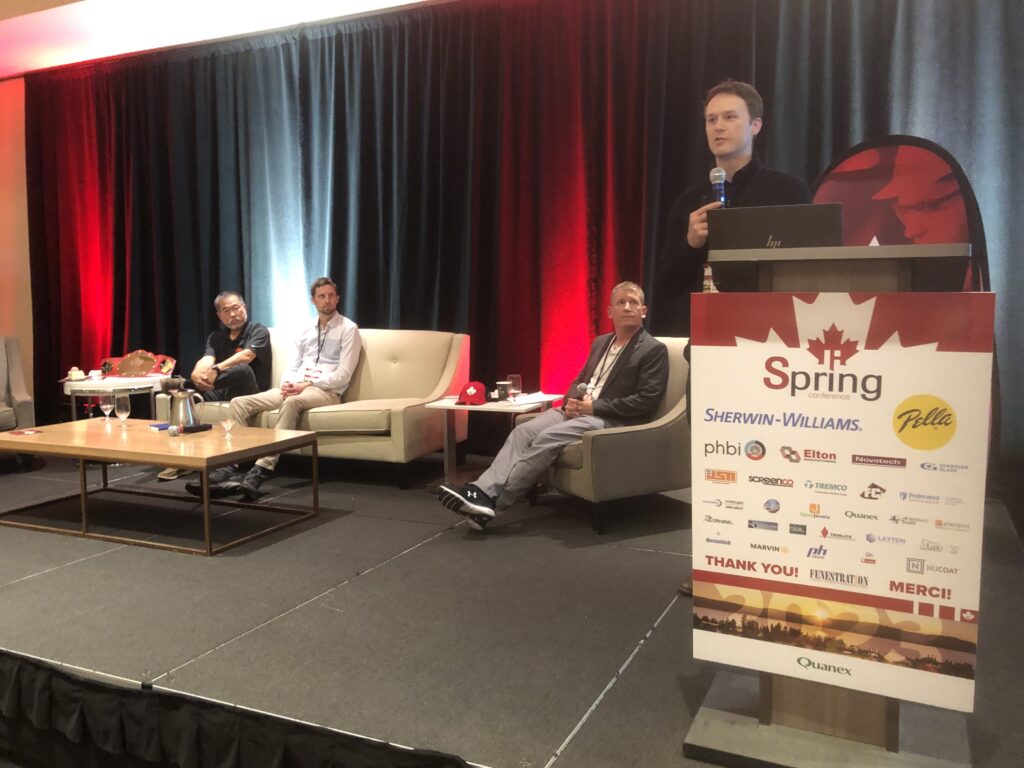
Features
Association news
Community
Contracting
Event reports
Fabrication
Commercial concerns take centre stage at FenCan
June 13, 2023 By Patrick Flannery
 From left, Jeff Makimoto, FenCan Commercial technical director; Brent Friesen (Baywest Glazing), FenCan Commercial chair; Rich Porayko, FenCan Commerical business development director; Jonathan Adams (Layton Consulting)
From left, Jeff Makimoto, FenCan Commercial technical director; Brent Friesen (Baywest Glazing), FenCan Commercial chair; Rich Porayko, FenCan Commerical business development director; Jonathan Adams (Layton Consulting) Fenestration Canada debuted its new commercial division with a panel discussion titled Commercial Pain Points at its Spring Conference in Kelowna, B.C., on May 24. The discussion focussed on several topics of particular interest to architectural glazing contractors and glass fabricators and represented a departure from FenCan’s usual fare aimed at residential window and door manufacturers. Many interesting points and insights were raised and one left with the impression the conversation could have gone on for much longer…as no doubt it will at future events.
On stage were Jonathan Adams, COO and partner at Layton Consulting in Surrey, B.C.; Brent Friesen, president of Baywest Glazing in Langley, B.C., and chair of FenCan Commercial; Jeff Makimoto, FenCan’s commercial technical director; and Rich Porayko, commercial business development director for the association.
Adams set the table with a presentation explaining structural glass standards covering balustrades, building guards and safety glass and pointing to several misconceptions and misuses of them. The standards under discussion were CAN CGSP 12.1; CAN CGSP 12.20 M89, ASTM E1300 and CSA A500. Adams’ big point was that there’s a lot more to safety glazing than is covered in the standards.
“The safety glazing standard is focused on one key part of safety and one part only,” he explained. “That is reducing the likelihood of injury to a person when when they’re interacting with glass. The standard also does not address strength, or durability, or fire-rated things.”
Another part of Adams’ presentation that was of particular interest to glazing contrractors was his discussion of the roles of the Registered Professional of Record and Supporting Registered Professional on a project. Briefly, the RPR is the architect or lead engineer with final responsibility for certifying construction as complete and to plan, and SRPs are one or more professionals to whom the RPR might delegate authority for checking aspects of the project and reporting on their readiness. It’s a fairly simple system in concept, but Adams addressed the many issues that arise in practice.
“Some of the things that we often come across are the subcontractor maybe doesn’t know who the RPR is,” Adams said. “The RPR doesn’t know who the SRP is or the subcontractor. This is what we commonly see, this is just the way it has been in many cases. The subcontractor doesn’t notify the SRP of the installation progress until the installation becomes complete. And then the RPR asks for the documents. Well, a field review has to be done. And if we can’t go on site to see things like fasteners because they’ll cover it up with with trim and things like that, then how can we provide these documents? So it’s really in the glaziers best interest to, early on, make sure that you know if an SRP is required, who the RPR is, and to make sure that that the SRP is getting on site to review your proof for your project so that you don’t have to start tearing stuff out after the fact. I think my advice would be just press whoever is hiring you to figure out who those individuals are so that we can at least ensure that somebody is taking responsibility, right? The architect may say, ‘I don’t need supporting professionals,’ but it’s up to him to make that call, not the contractor.”
Print this page
Leave a Reply